We hear from so many people starting an email list that they have NO idea what to send to people who have opted-in to their list. Fortunately, we have some good news about email marketing:
There are many different types of marketing emails, and they can all work.
The important thing is that choose a format and start sending emails. After all, when people opt-in, they expect to hear from you!
In this guide we’re giving you 19 email types that you can send to your email list, what to include in them, and when to send them. Everything you need to create an effective email marketing campaign.
To be clear: You don’t have to send all of these emails.
The kinds of marketing emails you send your subscribers will largely depend on your brand, business model, and the type of marketing promotions you run. Some types of emails won’t make sense for your business, while some you’ll find yourself using time and time again.
Here are 19 different types of marketing emails you can send to your subscribers to generate more engagement, build brand loyalty, and ultimately drive more conversions.
Table of Contents
What are email marketing campaigns?
A well-planned email marketing campaign can help businesses achieve their goals, whether it’s generating traffic, increasing brand awareness, re-engaging customers, or driving revenue.
Types of Marketing Emails
There are various types of email marketing campaigns, each serving a unique purpose:
- Promotional Emails: These emails promote your offers. Think of them as your digital sales pitch, designed to entice your audience with irresistible deals and exclusive content.
- Informational Emails: Newsletters are among the most popular informational emails. As the name suggests, a newsletter shares news related to your business. It’s like a friendly update, keeping your subscribers in the loop about what’s happening in your world.
- Retention Emails: Retention emails keep your customers happy and always coming back for more. These emails are a valuable cornerstone of email marketing since acquiring a new contact is more costly than retaining an existing one. Think of them as your way of saying, “We appreciate you and want to keep you around.”
- Transactional Emails: Transactional emails are what they sound like—they’re the emails someone gets when they’ve become a customer. Yes, they are different than marketing emails, but you still have the opportunity to market in these emails, which is why we’re including them here.
By understanding and utilizing these different types of email marketing campaigns, you can create a comprehensive email marketing strategy that addresses various aspects of your business and customer needs.
Related: Email Marketing Metrics Everyone Should Track.
Email Marketing Strategy
A successful email marketing strategy is essential for businesses to achieve their goals. Here are a few tips if you’re just getting started:
Simple Steps for Creating an Effective Email Marketing Strategy
Define Your Target Audience
Understand who your target audience is, what their needs and interests are, and what type of content they will engage with. The more you know about your audience, the better you can tailor your emails to meet their expectations.
Set Clear Goals
Clear goals will help you measure success.
Choose the Right Email Marketing Platform
Select an email marketing platform that meets your needs, such as Mailchimp, Constant Contact, or HubSpot. The right platform can make a significant difference in the efficiency and effectiveness of your campaigns.
Create Engaging Content
Develop content that resonates with your target audience, including compelling subject lines, engaging email copy, and eye-catching visuals. Remember, your content should provide value and encourage your subscribers to take action.
Optimize for Mobile
Ensure that your email campaigns are optimized for mobile devices, as more and more people are checking their emails on their smartphones. A mobile-friendly design can significantly improve your open and click-through rates.
Measure and Iterate
Track your email marketing metrics, such as open rates, click-through rates, and conversion rates, and use this data to improve your future email campaigns. Continuous improvement is key to long-term success.
Remember, a well-executed email marketing strategy is not just about sending emails; it’s about building relationships and providing value to your subscribers.
When should I send marketing emails?
Finding the perfect moment to send an email to your list is akin to knowing exactly when to lean in for that first handshake or high five in a burgeoning friendship. It’s all about reading the room—or in this case, understanding the daily ebb and flow of your subscribers’ lives.
With a blend of understanding, testing, and a dash of industry insight, you’ll not just reach their inbox; you’ll resonate.
Understanding Your Audience
First up, let’s talk about getting to know your audience’s schedule. Are they morning people, sifting through emails with their first sip of coffee? Or do they belong to the night, catching up on the day’s correspondence in the quiet hours? This isn’t about wild guesses; it’s about tuning into their routine and finding that sweet spot.
Testing and Optimization
Now, don’t just rely on industry best guesses or hearsay. Your audience is unique, and they deserve a personalized approach. This means rolling up your sleeves and getting into some A/B testing. Send out your emails at different times and days, then watch those metrics. This is how you’ll find your timing groove based on real feedback from your listeners.
Consider Email Marketing Best Practices
There’s wisdom to be found in broader trends. Tuesdays and Thursdays often emerge as champions of the email world, with mid-mornings snagging the spotlight. But remember, these are starting points—not universal truths. Your audience might march to the beat of a different drum.
Factor in Frequency
How often you reach out plays a major role in finding your ideal timing. Is it a weekly newsletter check-in or a flash sale alert? Each has its own rhythm and place in your audience’s inbox. The goal is to be present without becoming overwhelming, maintaining a gentle, consistent drumbeat that keeps your brand top of mind.
19 Types of Marketing Emails
As we’ve already mentioned, you likely won’t send out every type of marketing email. These are just a few to help you get started.
1. The Welcome Email
When you convert new subscribers to your email list, it’s like you’re starting a new relationship.
You’ve already successfully courted them, but there’s still so much they don’t know about you. And if you jump in too quickly, it could freak them out and drive them away, breaking up with you forever…a missed connection, if you will.
In email marketing, when a subscriber breaks up with you, they do it through unsubscribing.
It’s not them. It’s you.
That’s why you need to send this email – and why it should be one of the first emails your subscribers receive when they opt in.
Your welcome email is like an accelerated “getting to know you” period. It should thank the new subscriber for signing up for your email list, tell them a bit more about you and why your website exists (and what’s in it for them), and begin to build rapport with them. Building customer loyalty from the start is crucial for long-term engagement and retention.
Danavir from CopyMonk.com does this well:
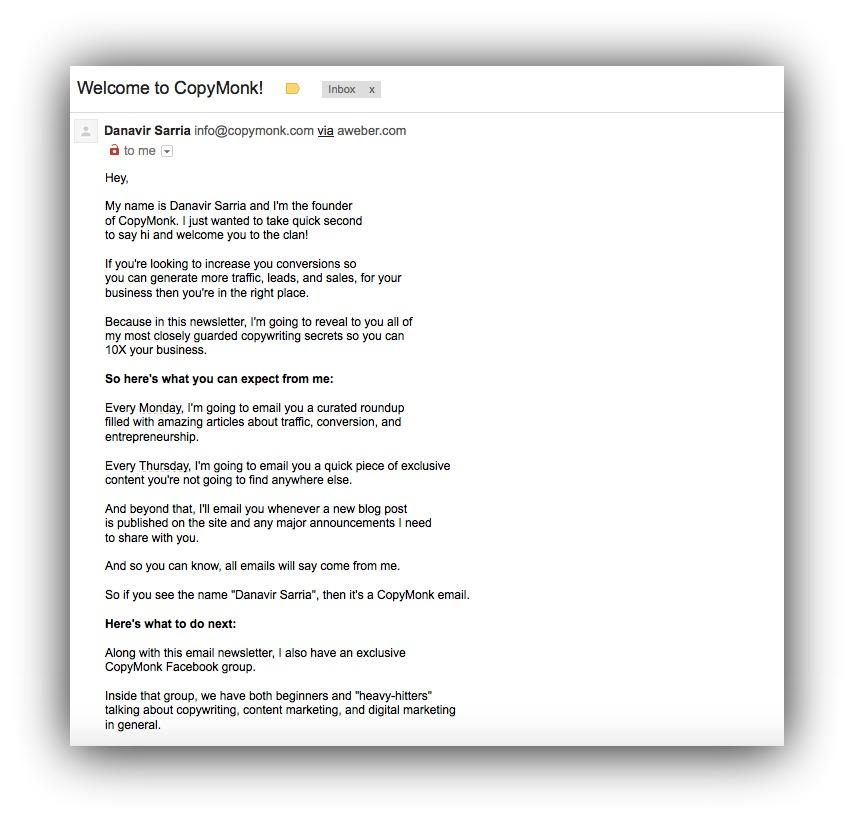
In this email, include a call to action of what you’d like your subscribers to do next, like join your Facebook group. Take advantage of that action taking momentum they gained by signing up for your list!
When to send it: Send this email right away – it should be the first email that automatically gets sent to them when they subscribe.
2. The Expectation Email
When somebody first subscribes, they don’t know what to expect from you.
And hey, if they subscribed from an opt-in offer or a content upgrade, they might not even know that by opting in for that upgrade, they subscribed to your email list.
This is a good opportunity to set the expectations around when they can expect your emails, what you’ll be sending them, and to build anticipation and buzz so they open your future emails.
That’s where an expectation email comes in. You can create this as a standalone email after the welcome, or include expectations in your welcome email.
This email should include:
- When you’ll send emails. If you can communicate exactly when to expect your emails, some subscribers will look forward to them.
- How often you’ll send them. Will you be sending daily emails, weekly, or biweekly?
- What you’ll send. Even if you told them when they opted in, still give them a reminder.
- A call to action to whitelist your email address. As your subscribers whitelist your email, it communicates to your email service provider that your emails do not belong in spam. This is crucial because internet service providers, like Gmail and Yahoo, often flag bulk emails as spam if not properly whitelisted.
When you set the expectations, your subscribers won’t be thrown off when they see your name crop up in their inbox. As more people open and take action from your emails, it sends a message to the different email clients (like Gmail) that you’re legit and not an evil spammer.
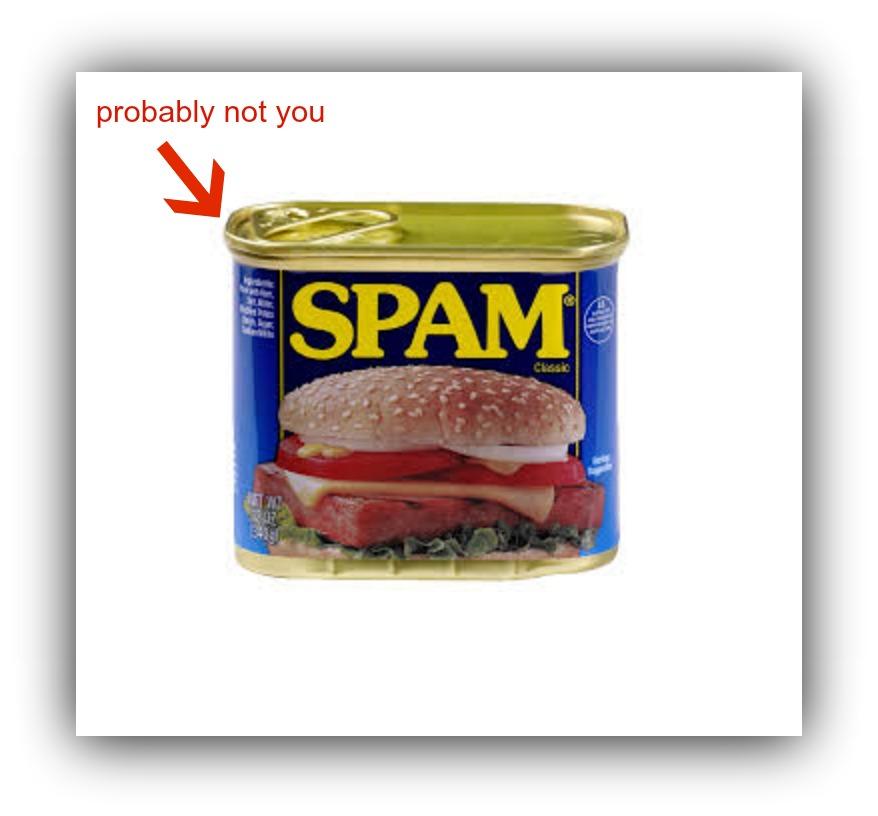
When to send it: Send this email within the first couple of days of subscribing, directly after your welcome email.
3. The Tools Email
I’m going to call you out on it…
You love silver bullets.
Those quick fixes that magically solve everything. It’s not just you. I do, too. But the problem is that silver bullets come from the land of unicorns with gold-plated manes that vomit rainbows of glittery confetti.
They don’t exist. Even though silver bullets are non-existent, there’s something that comes pretty close: tools.
So one email that will delight your subscribers is a list of tools you use. Include a mix of free and paid tools (including affiliate links if possible) to help your audience reach a goal or achieve an outcome.
Steve Chou from MyWifeQuitHerJob.com does this in one of the emails in his autoresponder series:
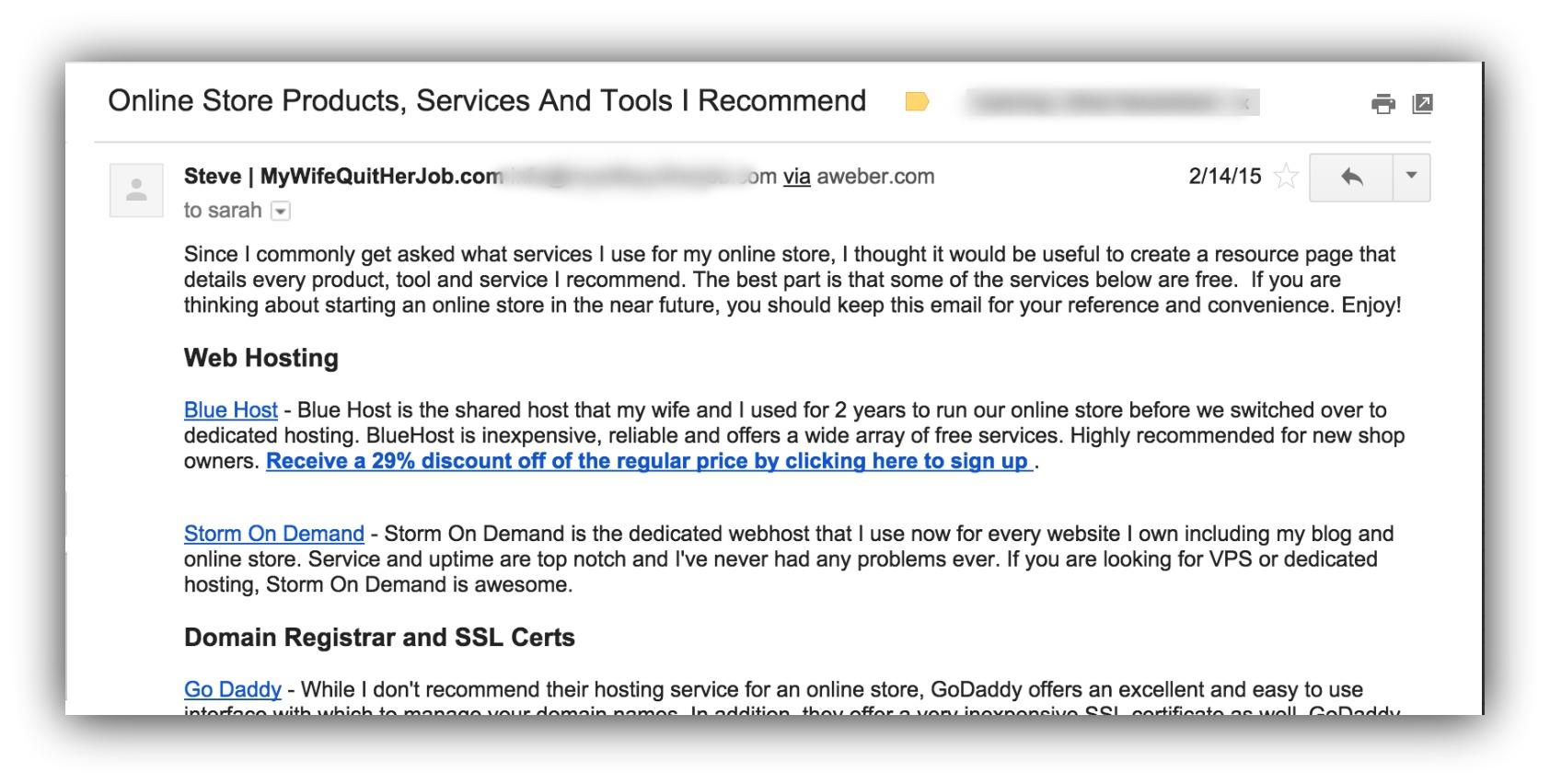
Steve included some affiliate links and free tools to help his audience build an online store. This is a great email marketing example of how to provide value and engage your subscribers.
When to send it: Toward the beginning of your autoresponder series while your list is the most engaged.
4. The Helping Email
This is meta…
But if you’re struggling with what to send your email list, there’s a way to get your subscribers to tell you exactly what to write your next email about to absolutely delight them.
And that’s asking them.
*Gasp*
Surprising, right?
Asking your audience what challenges they’re experiencing on your topic not only helps make your job as a content creator far easier as you begin to receive answers, but it also provides you with great market research into exactly what your audience wants.
As a huge bonus, they’ll respond with the exact words they use to describe those challenges, which is perfect for your sales copy, content, and even emails.
Plus, nobody likes a new friend who only talks about themselves.
Within the first couple of weeks of your new subscriber being on your list, send them an autoresponder email inviting them to hit reply and let you know what their challenges are around your topic.
To maximize the amount of responses you’ll get, let your subscribers know that you’ll read each one (but only if you truly will do it). You’d be surprised as to how many more responses you’ll get.
When to send it: Within the first couple of weeks.
Re engagement emails can also be a cost-effective way to turn inactive subscribers into active customers by asking for feedback and improving overall engagement rates.
5. The Getting to Know You Email
Have you ever gone on a date with somebody who won’t stop talking about themselves?
They have a story for everything, and are so self absorbed that they never even ask you one single question about yourself or your life.
It’s annoying, right? A complete deal breaker for most of us. You don’t want your emails to be like that, do you? It’s a two way street, and should be approached like a conversation. As an entrepreneur and marketer, you want to know as much about your subscribers as possible
The more information you get from the people on your list, the more targeted your marketing, the less time you have to spend on it, and the more you can sell.
So in this email you’re asking them to respond back to you with information about themselves.
Unlike the helper email, you’re not asking just for their challenges with your topic. In this email you’re asking them about their lives and experience with your topic in general.
This email also gives you insight into the exact type of person who you’re attracting onto your email list. You can gather information about your current and target customer, which will make it far easier to market to them. Additionally, engaging with existing customers through personalized communication can boost retention and provide valuable customer insights.
When to send it: Within the first couple of weeks
6. The Customer Loyalty Favor Email
One of the best things about having an email list is that you have a group of people who you can ask to take action on something – and who will usually follow through at much higher rates than the general public.
So that means that when you have a goal you want to achieve – or even simply want testimonials – you can just send an email.
Jeff Goins did this with his email list when he wanted to get more book reviews for his book The Art of Work:
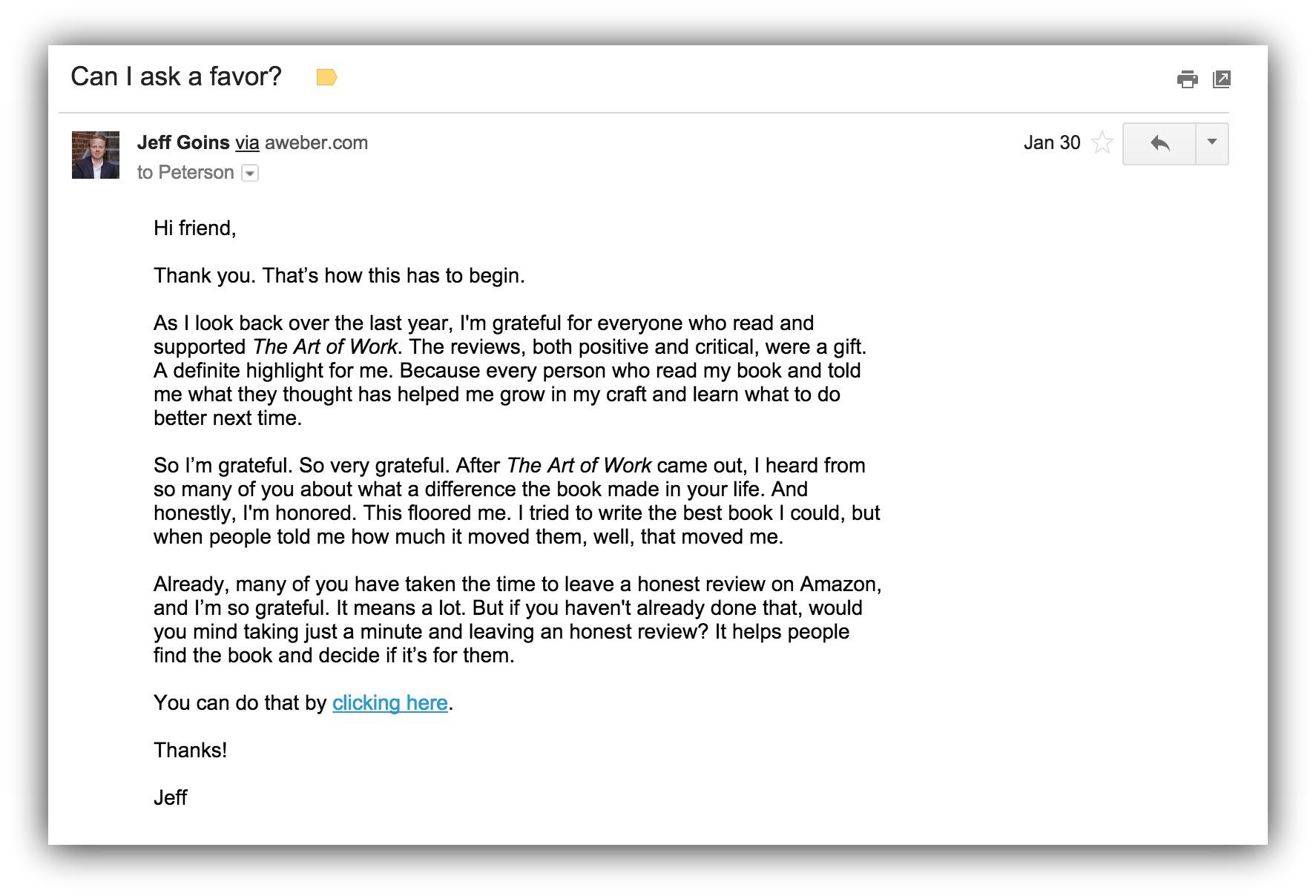
As you build rapport with your subscribers, they’ll want to support you, and will often go out of their way to help you out. This is especially true for loyal customers, who appreciate tailored communication and relevant promotional emails.
When to send it: After you’ve built rapport with your subscribers
7. The Unexpected Freebie Email Click Through Rates
Your email subscribers are some of your biggest fans.
They support you, provide a ton of great market research data, and are often the people to share your content and buy from you.
So they deserve to be treated every once in awhile.
Let’s go back to the dating analogy. When you’re courting somebody, one surefire way to impress them is to surprise them.
Just like that woman you’re trying to impress, there’s no better way to delight your current fans and subscribers than giving them unexpected freebie or gift
Every once in awhile, send your subscribers a treat – maybe a worksheet, a video, or a tool to help them out – something that will come as a nice surprise and remind them that it was a good idea to subscribe in the first place.
Check out how Brenda from Crave the Benefits does this:
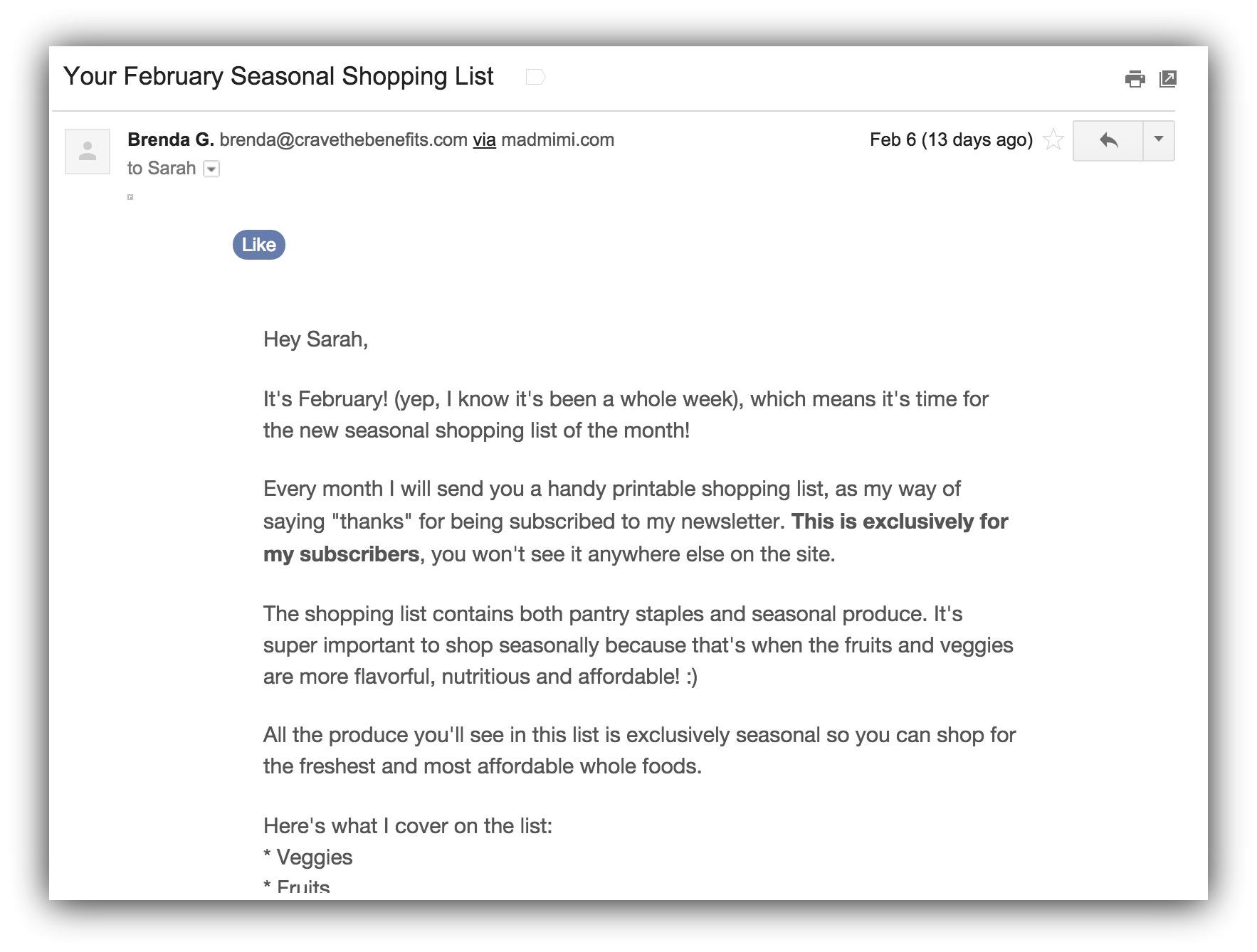
With a free printable shopping list exclusive to her subscribers that she sends monthly.
What can you spoil your subscribers with?
When to send it: Early and often.
Sending these unexpected freebies not only delights your subscribers but also strengthens customer loyalty by showing appreciation and fostering a deeper connection.
8. The Exclusive Content Email
If you’re just going to send your email subscribers the same content you publish on your Youtube channel, podcast, or blog, what’s the draw to subscribe?
I mean, besides the “saving them from having to check your website constantly” thing (which, by the way, they won’t).
That’s why you have to send your list exclusive content.
Remember how I said that you should be treating your subscribers like gold? That means sending them information that is exclusive to just them.
This doesn’t mean you have to spend another 40 hours writing an epic guide. You can give your subscribers exclusive content in a shorter form, like quick tips as Brian Dean from Backlinko did:
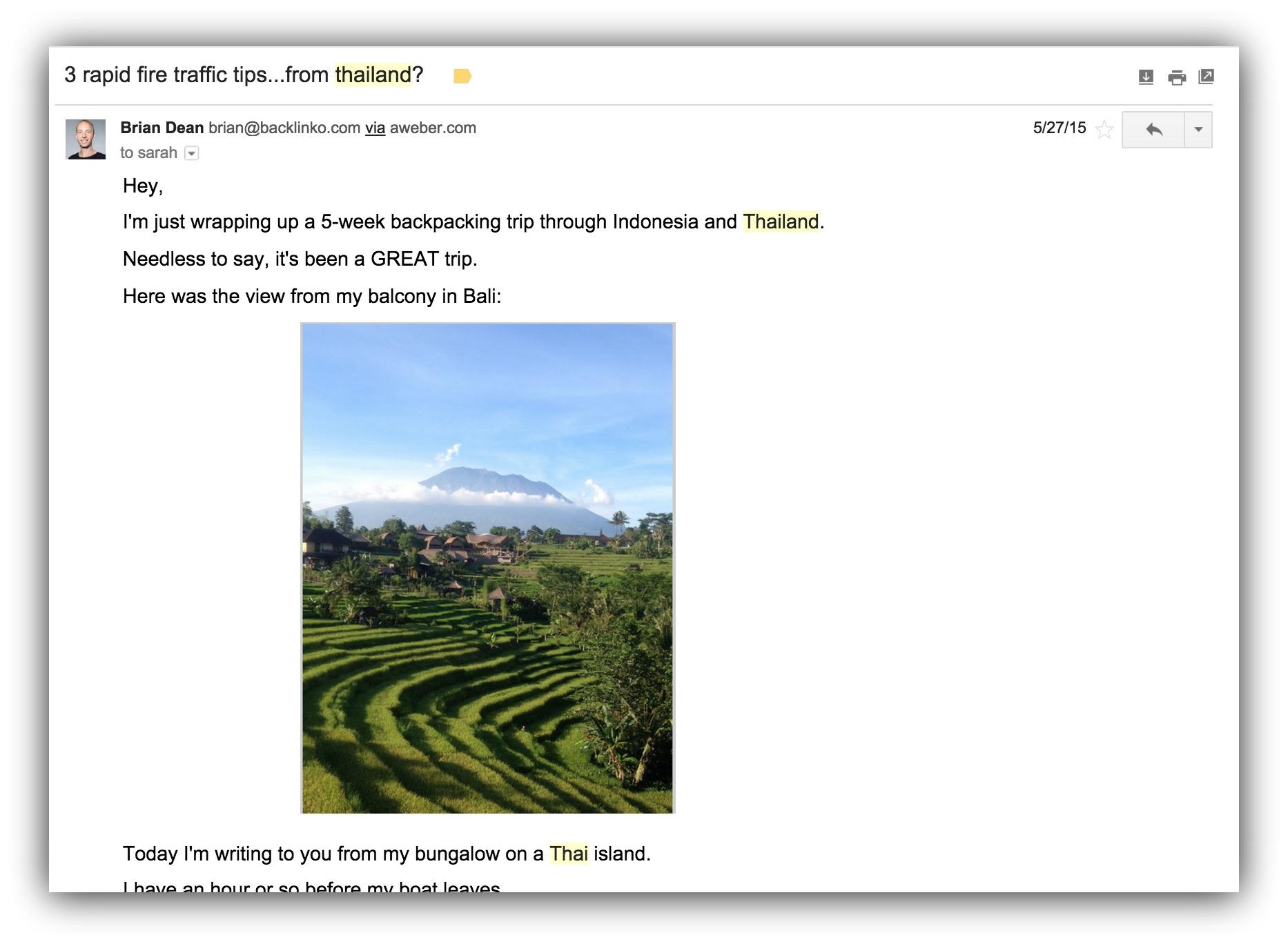
He sent an email to his list with rapid-fire traffic tips that were exclusive to his subscribers. This is one of the many effective email marketing examples that showcase how exclusive content can engage subscribers and drive conversions.
What can you send to your list that is exclusive just to them?
When to send it: Punctuate your autoresponder sequence with these emails. The more exclusive, valuable content you provide to your list, the warmer your list will be.
9. The Content Email
One of the best ways to get your content in front of more eyes is by sending it to your email list.
Shocking, right?
That means content you publish for everybody. So you’re not just sending exclusive content – they deserve to know about your public content as well.
There are two ways you can do this – one through content emails, and one through content teasers.
Before you choose, you should think about what your priority is. Is it:
- Traffic? If so, go for content teasers.
- Getting your content in front of your subscribers? If so, go for content emails. Content emails can also be used to keep your subscribers informed about company news and events, which aids in customer retention and engagement.
Once you’ve established your priority, think about your call to action. What do you want your audience to take action on? Do they need to be on your website to take action? If so, chances are you’ll be better served going for content teasers.
When most people think of an email list they think of an RSS feed that pushes email straight to the inbox of “subscribers”.
In this type of email, you’re sending the entire piece of content, and different email service providers call this different things:
- Aweber calls this Blog Broadcasts
- Mailchimp calls this RSS to Email
- Kit calls this RSS to Broadcast.
You can set this up in your email service provider to pull from your RSS feed automatically and email your list every time you publish content, or you can take the time to style the emails yourself for a more personalized tone.
If your goal is to get your subscribers back to your website, however, you may prefer to take the next path…
CONTENT TEASERS
Content teasers are a great way to get your email subscribers onto your website because they are meant to excite your subscribers about a piece of content you’ve published, leading to the link (which is the main call to action).
Amy Porterfield uses content teasers for her new podcast episodes:
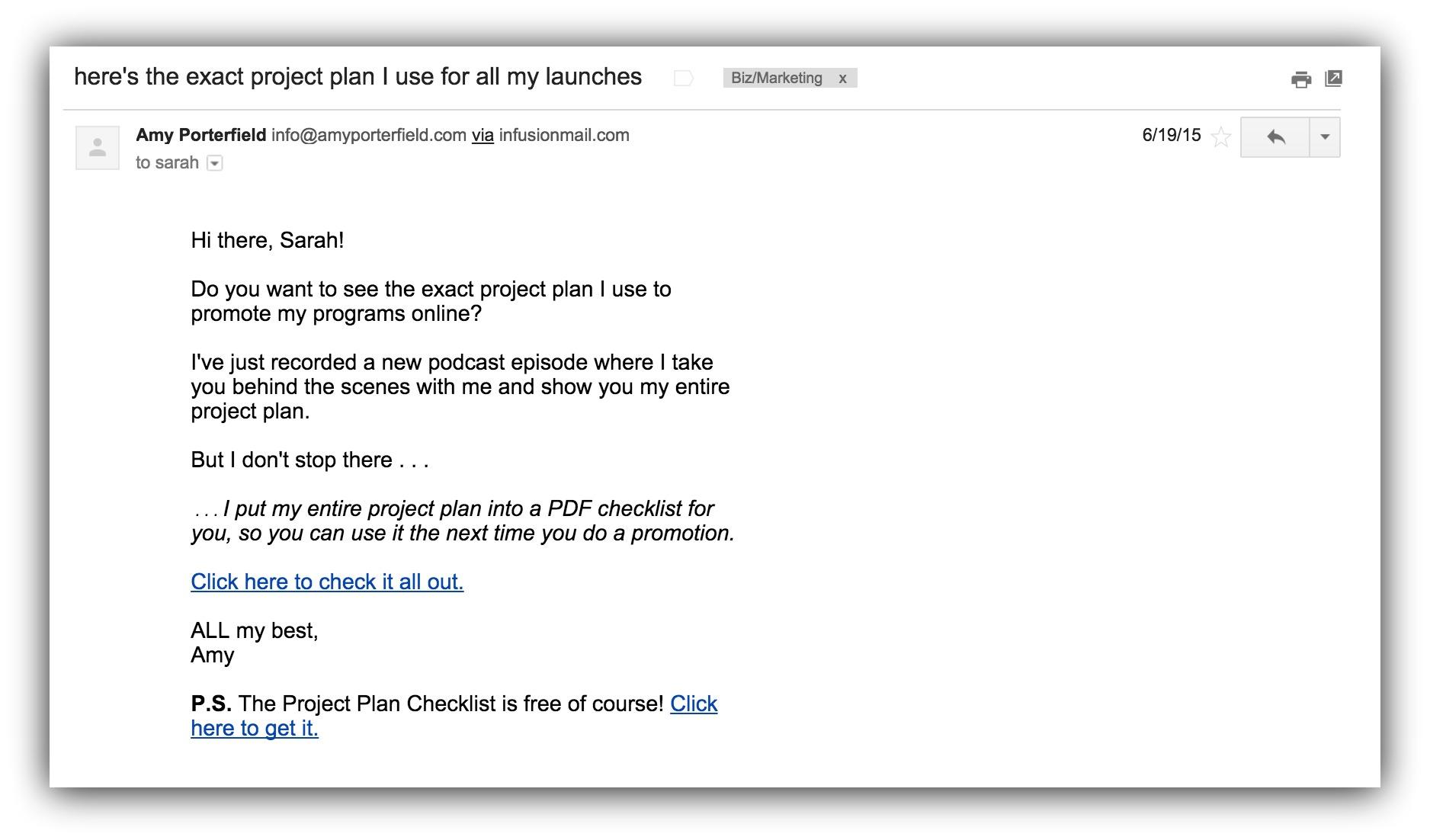
Because the reader doesn’t consume the entire email in their inbox, content teasers get your audience back to your website, so they can take action on your calls to action, share your content, and leave a comment.
When to send it: Any time you publish a new piece of content.
10. The Archive Email
Remember that epic piece of content you worked so hard on?
The scary thing is that after that content has marinated for a little while, your new visitors and email subscribers will never see it.
That is, unless you get it in front of them again.
When you’re consistently creating content, it’s easy for your older content to slip into the archives, never to be consumed by your target audience.
You can either do this by teasing one piece of archived content in your email, like a retro content teaser, or you can take these other approaches to pulling content from your archives. Leveraging archived content effectively is a key strategy in successful email marketing campaigns.
THE “START HERE” EMAIL
Have you ever landed on a website and became overwhelmed with all of the information to start digging through?
That’s why a lot of bloggers and website owners establish “Start Here” pages on their websites.
And just like on a website, when your email subscribers first end up on your email list, they can become overwhelmed. There’s so much to do, that it can be difficult to know where to start.
That’s where the “start here” email comes in.
This email is like a roadmap that guides your audience through your website and content in an organized way.
THE RESOURCE GUIDE
If you’ve been creating content and products for a long time, and you have a portfolio of work that would be difficult for your audience to weed through, providing subscribers with a resource guide to direct them through your content and products can get not only be a great way to get eyes on the content, but also provide a roadmap.
John Lee Dumas from Entrepreneur on Fire has done this:
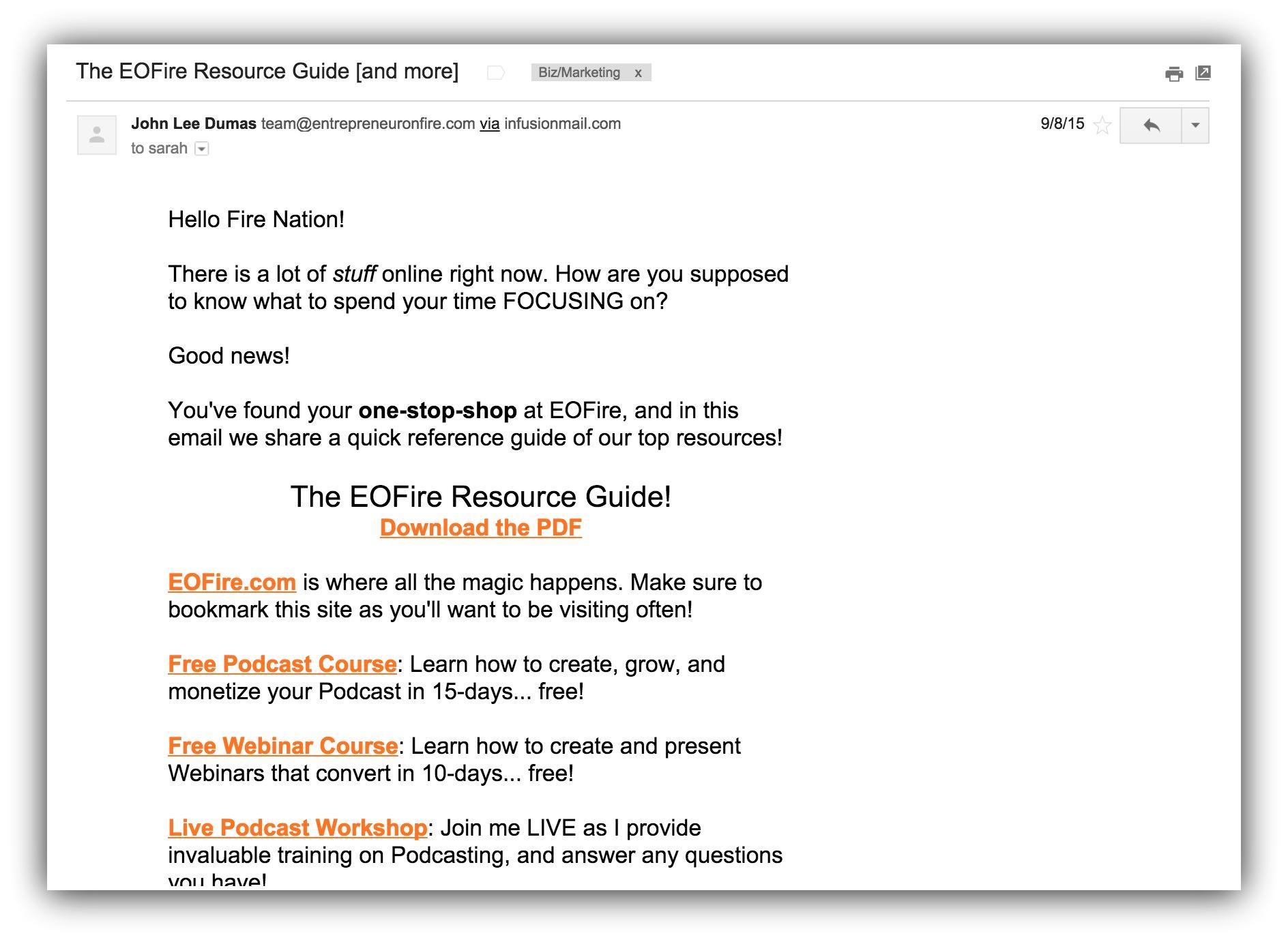
This helps your audience through your content while also providing them value.
THE FAVORITE POSTS EMAIL
If you’re fancying something a little shorter, you can always reach back into your archives to your favorite pieces of content and curate them.
Listing your favorite pieces of content with a short summary gives your audience value while also getting more eyes on your archived content.
Instead of going deep into your archives like the other types of archive emails, you’re just picking your very favorite 5-10 pieces of content or curating the most popular posts on your website, like Nat has done:
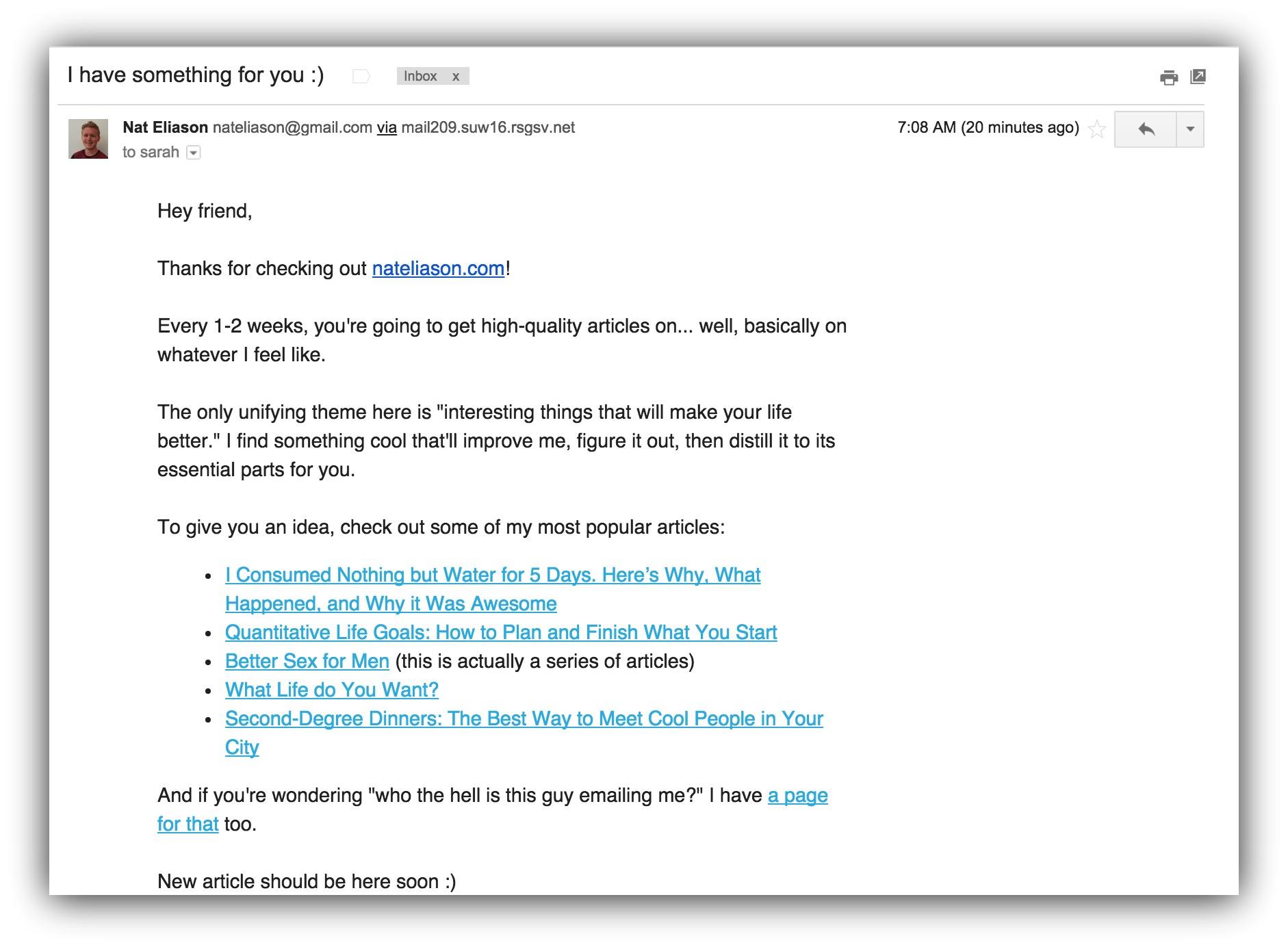
It’s a win/win.
When to send it: Close to the beginning of your autoresponder series.
11. The Curated Email
Look, I get it.
Creating content – whether it’s email content, blog or podcast content, product content – it’s a lot of work. And you have a million other things to do on top of content creation.
So give yourself a break. Train your audience to click on your links, get some good will out there into the internet and share other people’s content so you don’t have to spend the time to create your own.
Cait Flanders from Blonde on a Budget did this with one of her recent emails:
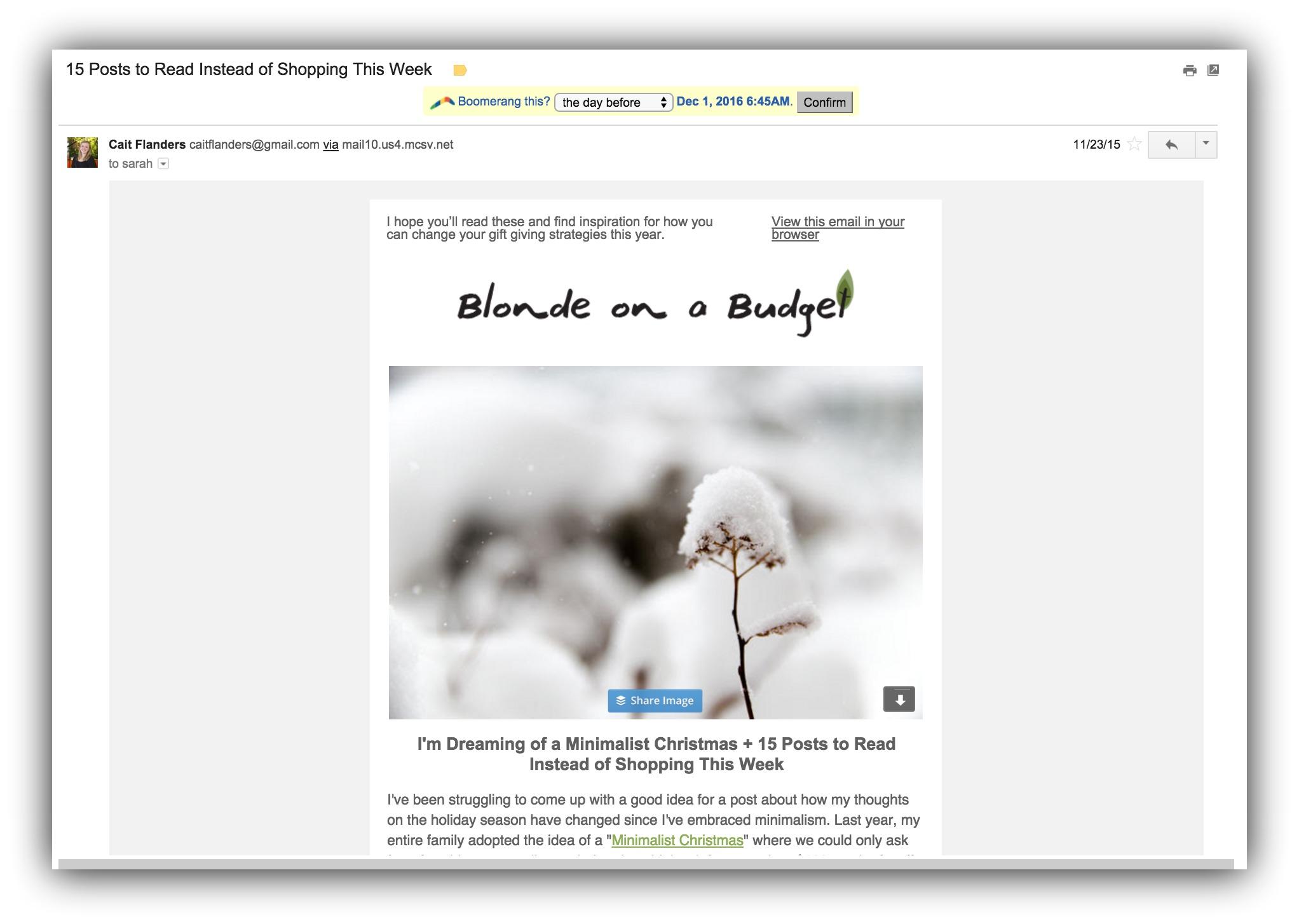
She listed 15 different articles she enjoyed for her audience to read. Good karma, great reading material, and less work.
When to send it: Either regularly or whenever you’re feeling overwhelmed and need a break.
Incorporating this approach into a well-planned email campaign can significantly boost engagement and achieve specific marketing goals.
12. The Newsletter
Aside from content emails, the most common type of email to send your subscribers tends to be a newsletter.
You’ve likely seen List Builders like this all over the internet:
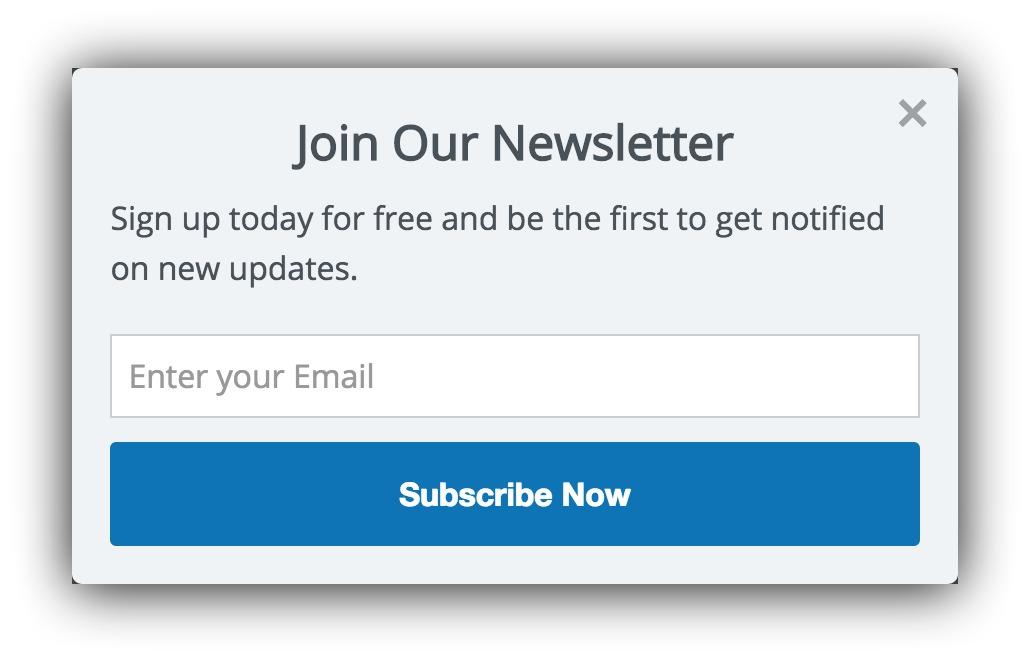
Maybe you’ve even left that as your call to action on your own List Builder (despite that you now know better – tsk tsk).
Newsletters are the granddaddy of email marketing, and they’re exactly as they sound: regular updates that tend to be more personal in nature about the company or individual behind the newsletter.
While I don’t recommend you only send newsletter updates, the occasional or even regular newsletter update can help your audience get to know you better and build rapport with them.
When to send it: When you have updates for your email list that you can curate into a newsletter. Newsletters can also be used to keep customers informed about company news and events, aiding in customer retention and engagement.
13. The Buzz-Building Email
Have something big and exciting coming down the pipeline?
Maybe you’re working on a new product, an exciting project or even just a freebie you know your audience will love. Instead of just sending your list an email when it’s released, why not build buzz and anticipation?
Send an email before your new project is released to get your subscribers as excited as you are about it. These buzz-building emails are a crucial part of effective marketing emails, helping to improve consumer engagement and drive conversions.
When to send it: Any time you want to build anticipation for something exciting.
14. The Testimonial Emails
You know how well testimonials work, right?
We’ve told you all about how testimonials can increase conversions, give you social proof and establish you as an expert.
So why not include testimonials in your autoresponder series?
Especially as you’re ramping up toward your sales emails, testimonials for your products, services, and even just content can pique your audience’s interest and establish credibility.
Jonathan Mead from Paid to Exist has done this:
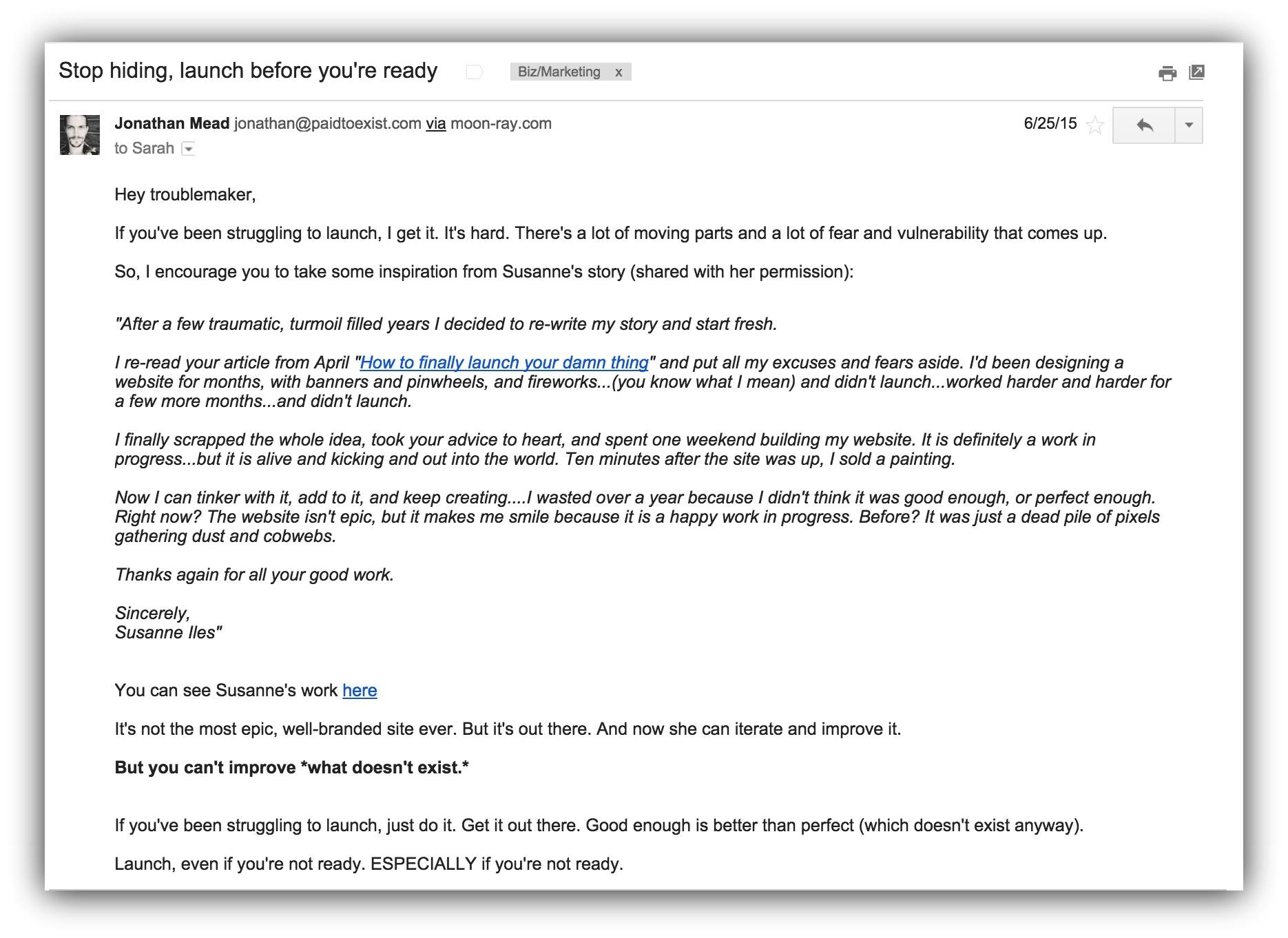
And he tied the testimonial back to a call to action in the rest of the email.
You can showcase the good work you do in your autoresponder series, too, by sending a testimonial email. An effective email marketing example is using testimonials to highlight best practices such as compelling call-to-action buttons and personalized offers.
When to send it: As you build up to sales emails and launches.
15. The Favorite Things Email
How does saving time, building a relationship with your audience and creating content at the same time sound?
Pretty awesome, right?
Thought so.
That’s exactly what you can do with this email. As you’re sending emails to your audience and engaging them with content, you’re triggering some curiosity with many of your subscribers. As they get to know your style a bit, they want to get to know you better, too.
So that’s why this email is so fun – the “favorite things” email. In this type of email, you’re saving time from creating new content by curating your favorite things related to your topic or just life in general. Noah does this with his email list:
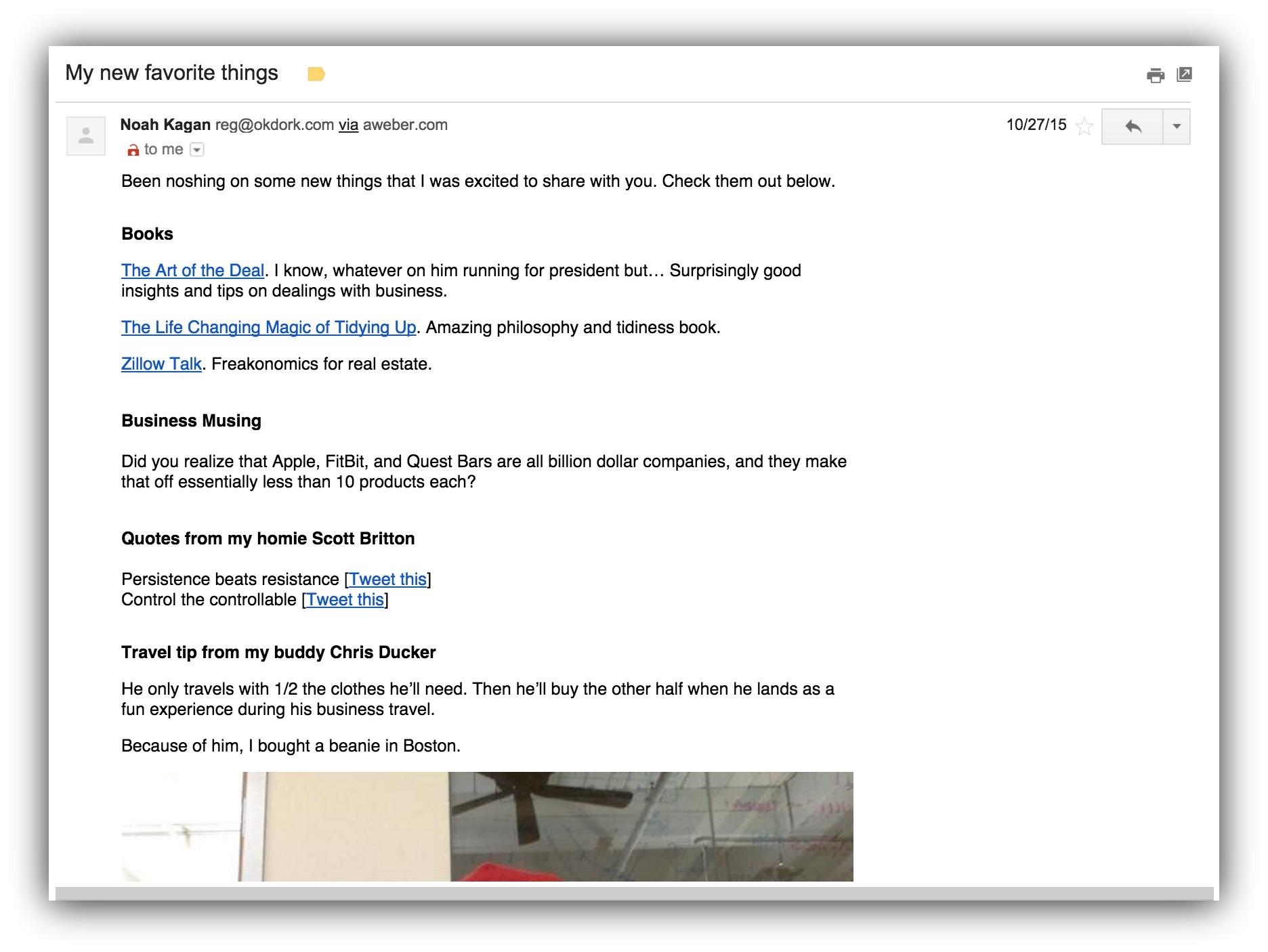
It can be a fun way for your audience to get to know you and give them a unique spin on the regular emails they receive from you. This approach can also enhance engagement and boost your click-through rate.
16. The Review Request Email
In the symphony of email marketing campaigns, the Review Request Email is the crescendo that helps amplify your brand’s credibility and authority. Much like a standing ovation at the end of a masterful performance, a collection of positive reviews can significantly boost your company’s reputation.
Imagine each review as a powerful testament to your brand’s commitment to customer satisfaction and quality. But how do you encourage your email subscribers to become vocal advocates for your products or services? This is where the art of asking comes into play.
Firstly, timing is everything. Your request should come after your customers have had enough time to experience and enjoy your offering. In your email copy, start by expressing genuine appreciation for their business. Then, with a clear and polite tone, invite them to share their thoughts and feedback.
It could be as straightforward as: “We hope you’re loving your purchase! Could you spare a few moments to share your thoughts? Your review not only helps us, but it also guides fellow customers.”
Always remember to include a direct link to the review page to make the process as seamless as possible. Reducing the effort required by your subscribers can greatly increase the likelihood of them leaving a review.
And here’s another tip to enhance your email marketing strategy: personalize the request. A personalized email that references the specific product they purchased or their name in the subject line can create a more compelling and engaging request.
When to send it: Schedule the Review Request Email to follow up a purchase after a period that allows for adequate product usage, typically 2-4 weeks, depending on the nature of the product or service.
17. The “Reply-to-Me with” … Email
In an age where email inboxes are battlegrounds for attention, the Reply-to-Me Email stands as a beacon of interaction, inviting your newest subscribers to step into a dialogue right from the start. Not only does this type of email encourage a personal connection, but it also serves a technical purpose: improving email deliverability.
When subscribers respond to your email, it’s a positive signal to internet service providers like Gmail that your messages are welcome, interactive, and thus should be kept away from the dreaded spam folder. This type of email is a small yet mighty tool in your email marketing arsenal that can yield big results.
Enticing your audience to hit ‘Reply’ might seem challenging, but it’s all about asking the right questions. Once a subscriber opts in, perhaps with the help of a double opt-in, prompt them with a simple question that requires a personalized response. For example, “What’s the number one challenge you’re facing in [area relevant to your business]?” or “Hit ‘Reply’ and tell me the main thing you’d like to learn about [a topic you cover].”
This approach not only boosts your engagement and email deliverability but also provides invaluable insight into your target audience’s desires and pain points. You’re not just breaking the ice; you’re gathering information that can refine your marketing strategy, making your content more relevant and your campaigns more successful.
When to send it: The Reply-to-Me Email should be one of the first emails a new subscriber receives, ideally right after their welcome email, while their interest in your content is at its peak.
18. The Round Up Email
The Round-Up Email serves as a concise, curated digest, bringing together a selection of resources, articles, or tools on a specific theme directly to your subscribers. It simplifies the process of staying informed by offering a neatly packaged collection of insightful content that ranges from industry news to essential tools, all chosen to educate, inspire, and engage.
To create an effective Round-Up Email, start by identifying a theme that resonates with your audience and reflects your brand’s ethos. Then, handpick content that provides real value—this could be articles highlighting emerging trends, a compilation of tools for a specific task, or insightful posts from thought leaders. This approach not only positions you as an authority but also builds anticipation for your emails, making them a sought-after resource among your subscribers.
Remember to weave in a call to action that feels like a natural progression for readers wanting to delve deeper into the topics discussed. Whether it’s inviting them to read a full article on your website, explore a new product, or follow your brand on social media, the CTA should encourage further engagement.
The timing and frequency of sending a Round-Up Email can vary. Monthly round-ups are generally effective for providing a comprehensive overview of the month’s highlights, while weekly updates may better suit industries that experience rapid changes.
Overall, the Round-Up Email is more than just a marketing tactic; it’s a valuable service that packages relevant insights and resources in an easily digestible format, enhancing your relationship with your subscribers by consistently delivering convenience and quality content.
When to send it: Consider sending a round-up email each month.
19. The Abandoned Cart Email
An abandoned cart email is a gentle nudge to customers who have left items in their online shopping cart without completing the purchase. It acts as a reminder of what they’ve shown interest in, encouraging them to return and finalize their transaction. This email is pivotal for e-commerce businesses, serving as a strategy to recover potential lost sales by addressing hesitations or simply reminding customers of their initial interest.
Crafting an effective abandoned cart email involves a few key elements. Firstly, it’s important to catch the customer’s attention with a compelling subject line that reminds them of their unfinished purchase. The email itself should be clear and to the point, listing the items left in the cart with visually appealing images and product details to reignite the customer’s interest. Including a direct link back to the cart makes it as easy as possible for the customer to complete their purchase.
To add more incentive, some businesses choose to include a special offer, such as a discount code or free shipping, as an extra push for the customer to proceed with their purchase. This tactic not only helps in recovering the sale but also enhances customer satisfaction by providing added value.
Timing is crucial for abandoned cart emails. Sending the first email within a few hours after the cart is abandoned strikes while the iron is hot, keeping the products fresh in the customer’s mind. Follow-up emails can be scheduled if the first one doesn’t convert, but it’s important to maintain a balance and not overwhelm the customer with too many reminders.
Abandoned cart emails are a powerful tool in the e-commerce marketer’s arsenal, offering a direct way to re-engage customers who are on the fence. By thoughtfully crafting these emails and timing them right, businesses can significantly reduce cart abandonment rates and boost their overall sales.
STOP Leaving Your New Subscribers Hanging: Email Marketing Strategy
We see one big mistake over and over again…
You work so hard to get people on your email list and then leave them in the lurch. Days and then weeks and months go by without a single word from you…
Until they forget about you and why they signed up for your email list.
And guess what happens in those cases?
When you do finally send an email, they hit the Spam button faster than you can say “tacos”. And can you blame them? They’ve forgotten who you are.
So STOP leaving your new subscribers hanging. Spend the time to create an autoresponder series that will keep them engaged, interested, and responsive. Look at various email marketing examples to see how successful campaigns maintain subscriber interest.
Don’t Have An Email List Yet? Here’s 85 Ways To Build One
Add A Comment
VIEW THE COMMENTS